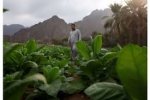The history of dokha begins with traditional Native American tobacco. These ultra-intense strains of wild North American tobacco were introduced to the old world by the European travelers and explorers. This tobacco advanced toward North Africa and spread east to Egypt, the Levant, and at last to down to the Arabian Peninsula. These one of a kind strains eventually reached places like Al-Buraimi in Oman and the Hatta Valley in present day United Arab Emirates. Tobacco was introduced to the Middle East in the form of a tall water pipe called a hookah or “nargile” in Arabic and Turkish. Due to the cost and maintenance of hookah smoking, tobacco was typically reserved for the elite of the time. Dokha was later created as an inexpensive and simple method of smoking for every class to enjoy. The first record of dokha in history goes back to the late 1500’s in the mountains of northern Iran where it was used recreationally and medicinally by the local population. During the 1800’s dokha turned into a mainstream trade in the Arabian Peninsula and surrounding regions. Farmers would cultivate and sell their product to British mariners and officers whom occupied the region during that era. With the advent of the cigarette at the turn of the 20th century, dokha took the backseat as the tobacco form of choice. It wasn’t until the 1980’s that dokha and the culture around it saw a massive resurgence in popularity in the Persian Gulf.
Popular as a niche tobacco in the Middle East for generations, “dokha” is the unadulterated, traditional, and unique Arabic tobacco. Unlike most tobaccos, dokha is not fire or air cured and cut, but rather sun-dried in the arid desert from which it’s cultivated. This subspecies of nicotiana is grown in extremely hot and dry conditions. These conditions combined with watering restrictions puts stress on the plant prompting it to increase nicotine and other alkaloid production. The dried leaves are finely ground within a few days or up to a few weeks as to preserve the color, quality, freshness, and flavor. Due to the far lesser degree of processing, dokha tobacco shows up basically unaltered and keeps up the green hue of the normal plant. The tobacco is then carefully mixed with leaves from each segment of the plant. The resulting mixes are regularly grouped into light or “barid”(cold dokha), medium or “daffi” (warm dokha), or hot or “harr” (hot dokha) blends.
In the past, residents of these desert regions smoked dokha because it gave them an invigorating and soothing head rush or “laf raas”. However, since it’s arrival, different farming methods and selective breeding has made some amazing progress for this tobacco throughout the years. What we have today is a far superior tobacco product that has been perfected for generations. In the history of dokha, traditionally it was blended with dried flowers, herbs, spices, and other flavorings to cool the strength and harsh temperature of the tobacco and enhance different flavor notes. Some Iranian and Turkish mixes would be blended with the barks and leaves of indigenous local plants. Unlike the history of dokha, present day Dokha, due to the demand of the market, is essentially 100% unadulterated tobacco without any additives like other tobacco products, which are fermented, aged, and processed with fillers and chemicals. And unlike most tobacco, dokha is cultivated using only fish meal and without the use of herbicides and pesticides.
When compared to other tobacco products, Most smokers who have delved into dokha are captivated by its unique attributes, the satisfactory buzz it gives to the smoker, and the superior flavor versus cigarettes, rolling tobacco, cigars or other pipe tobaccos.
Throughout the history of dokha, individuals that smoke noticed several advantages over other tobacco products besides the satisfying buzz. Because of the small amount of smoke and lack of chemicals, the smell of the smoke will not stick to any surface or fabric. Your hair, hands, and clothes will not smell unpleasant or invasive to other individuals around you. Nicotine stains on your hands will be a thing of the past. The amount of plant material smoked is far less causing less strain on your lungs. A cigarette contains between 1.4 to1 1.9 grams of tobacco versus 0.13 to 0.15 grams in a bowl of dokha.
Dokha is smoked out of a small narrow pipe called a “medwakh.” The length of the pipe and narrow chamber are designed to keep the smoke as cool as possible. The design of the pipe as well as the front tip near the bowl serve both functional and symbolic purposes. Symbolically, There are two shapes the front of the medwakh can possess. The curved tips represent a falcon’s talon. Falcon hunting is a national sports and favorite past time in the region. The straight tip represents the front of a canoe, paying tribute to the rich sailing tradition of the Persian Gulf. Functionally, The tip can be cupped in the palm of the hand allowing it to be lit in the constant desert winds. Originally, hollowed animal bones were utilized as both pipes and storage containers. Today, skilled workers carve these pipes using a variety of local and imported woods. Other materials such as bone, ivory, and an assortment of metals both common and precious are also used in creating these pipes. Higher quality medwakh are often accompanied with a container or “chanta” that there is a wide variety of styles of medwakh to accommodate everyone’s personal taste. The History of dokha has seen many variations from the original all leading to thetruly excellent product that we know today
.
Popular as a niche tobacco in the Middle East for generations, “dokha” is the unadulterated, traditional, and unique Arabic tobacco. Unlike most tobaccos, dokha is not fire or air cured and cut, but rather sun-dried in the arid desert from which it’s cultivated. This subspecies of nicotiana is grown in extremely hot and dry conditions. These conditions combined with watering restrictions puts stress on the plant prompting it to increase nicotine and other alkaloid production. The dried leaves are finely ground within a few days or up to a few weeks as to preserve the color, quality, freshness, and flavor. Due to the far lesser degree of processing, dokha tobacco shows up basically unaltered and keeps up the green hue of the normal plant. The tobacco is then carefully mixed with leaves from each segment of the plant. The resulting mixes are regularly grouped into light or “barid”(cold dokha), medium or “daffi” (warm dokha), or hot or “harr” (hot dokha) blends.
In the past, residents of these desert regions smoked dokha because it gave them an invigorating and soothing head rush or “laf raas”. However, since it’s arrival, different farming methods and selective breeding has made some amazing progress for this tobacco throughout the years. What we have today is a far superior tobacco product that has been perfected for generations. In the history of dokha, traditionally it was blended with dried flowers, herbs, spices, and other flavorings to cool the strength and harsh temperature of the tobacco and enhance different flavor notes. Some Iranian and Turkish mixes would be blended with the barks and leaves of indigenous local plants. Unlike the history of dokha, present day Dokha, due to the demand of the market, is essentially 100% unadulterated tobacco without any additives like other tobacco products, which are fermented, aged, and processed with fillers and chemicals. And unlike most tobacco, dokha is cultivated using only fish meal and without the use of herbicides and pesticides.
When compared to other tobacco products, Most smokers who have delved into dokha are captivated by its unique attributes, the satisfactory buzz it gives to the smoker, and the superior flavor versus cigarettes, rolling tobacco, cigars or other pipe tobaccos.
Throughout the history of dokha, individuals that smoke noticed several advantages over other tobacco products besides the satisfying buzz. Because of the small amount of smoke and lack of chemicals, the smell of the smoke will not stick to any surface or fabric. Your hair, hands, and clothes will not smell unpleasant or invasive to other individuals around you. Nicotine stains on your hands will be a thing of the past. The amount of plant material smoked is far less causing less strain on your lungs. A cigarette contains between 1.4 to1 1.9 grams of tobacco versus 0.13 to 0.15 grams in a bowl of dokha.
Dokha is smoked out of a small narrow pipe called a “medwakh.” The length of the pipe and narrow chamber are designed to keep the smoke as cool as possible. The design of the pipe as well as the front tip near the bowl serve both functional and symbolic purposes. Symbolically, There are two shapes the front of the medwakh can possess. The curved tips represent a falcon’s talon. Falcon hunting is a national sports and favorite past time in the region. The straight tip represents the front of a canoe, paying tribute to the rich sailing tradition of the Persian Gulf. Functionally, The tip can be cupped in the palm of the hand allowing it to be lit in the constant desert winds. Originally, hollowed animal bones were utilized as both pipes and storage containers. Today, skilled workers carve these pipes using a variety of local and imported woods. Other materials such as bone, ivory, and an assortment of metals both common and precious are also used in creating these pipes. Higher quality medwakh are often accompanied with a container or “chanta” that there is a wide variety of styles of medwakh to accommodate everyone’s personal taste. The History of dokha has seen many variations from the original all leading to thetruly excellent product that we know today
.









